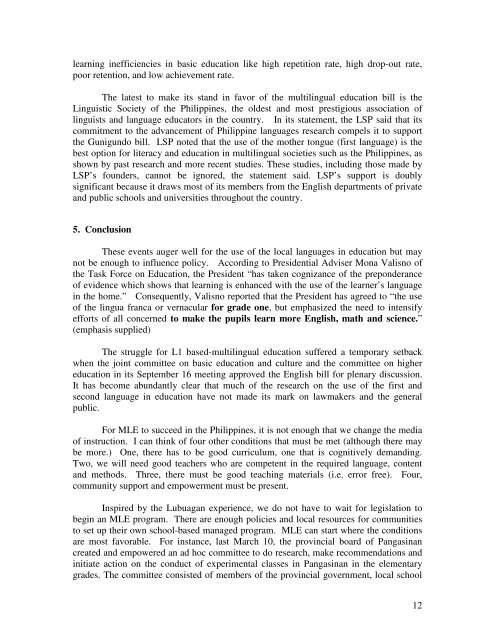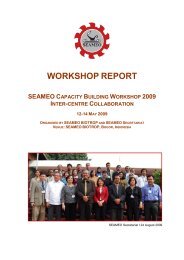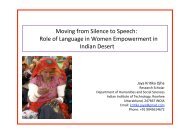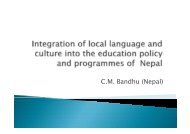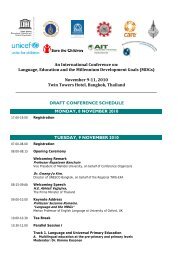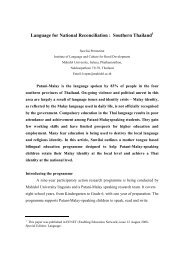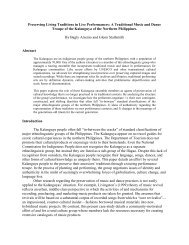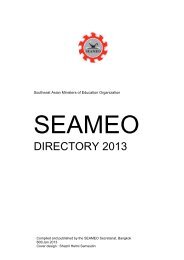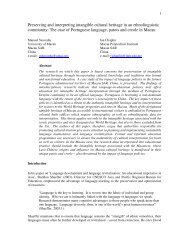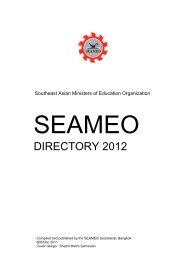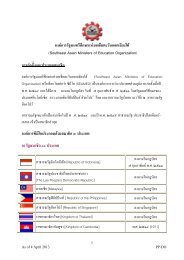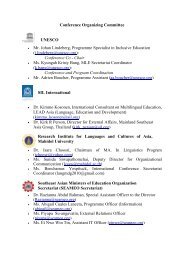THE PROSPECTS OF MULTILINGUAL EDUCATION ... - SEAMEO
THE PROSPECTS OF MULTILINGUAL EDUCATION ... - SEAMEO
THE PROSPECTS OF MULTILINGUAL EDUCATION ... - SEAMEO
You also want an ePaper? Increase the reach of your titles
YUMPU automatically turns print PDFs into web optimized ePapers that Google loves.
learning inefficiencies in basic education like high repetition rate, high drop-out rate,<br />
poor retention, and low achievement rate.<br />
The latest to make its stand in favor of the multilingual education bill is the<br />
Linguistic Society of the Philippines, the oldest and most prestigious association of<br />
linguists and language educators in the country. In its statement, the LSP said that its<br />
commitment to the advancement of Philippine languages research compels it to support<br />
the Gunigundo bill. LSP noted that the use of the mother tongue (first language) is the<br />
best option for literacy and education in multilingual societies such as the Philippines, as<br />
shown by past research and more recent studies. These studies, including those made by<br />
LSP’s founders, cannot be ignored, the statement said. LSP’s support is doubly<br />
significant because it draws most of its members from the English departments of private<br />
and public schools and universities throughout the country.<br />
5. Conclusion<br />
These events auger well for the use of the local languages in education but may<br />
not be enough to influence policy. According to Presidential Adviser Mona Valisno of<br />
the Task Force on Education, the President “has taken cognizance of the preponderance<br />
of evidence which shows that learning is enhanced with the use of the learner’s language<br />
in the home.” Consequently, Valisno reported that the President has agreed to “the use<br />
of the lingua franca or vernacular for grade one, but emphasized the need to intensify<br />
efforts of all concerned to make the pupils learn more English, math and science.”<br />
(emphasis supplied)<br />
The struggle for L1 based-multilingual education suffered a temporary setback<br />
when the joint committee on basic education and culture and the committee on higher<br />
education in its September 16 meeting approved the English bill for plenary discussion.<br />
It has become abundantly clear that much of the research on the use of the first and<br />
second language in education have not made its mark on lawmakers and the general<br />
public.<br />
For MLE to succeed in the Philippines, it is not enough that we change the media<br />
of instruction. I can think of four other conditions that must be met (although there may<br />
be more.) One, there has to be good curriculum, one that is cognitively demanding.<br />
Two, we will need good teachers who are competent in the required language, content<br />
and methods. Three, there must be good teaching materials (i.e. error free). Four,<br />
community support and empowerment must be present.<br />
Inspired by the Lubuagan experience, we do not have to wait for legislation to<br />
begin an MLE program. There are enough policies and local resources for communities<br />
to set up their own school-based managed program. MLE can start where the conditions<br />
are most favorable. For instance, last March 10, the provincial board of Pangasinan<br />
created and empowered an ad hoc committee to do research, make recommendations and<br />
initiate action on the conduct of experimental classes in Pangasinan in the elementary<br />
grades. The committee consisted of members of the provincial government, local school<br />
12


